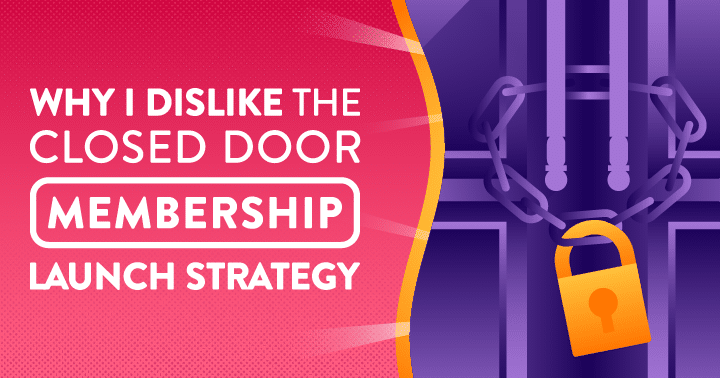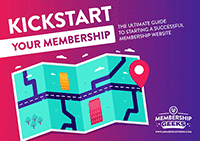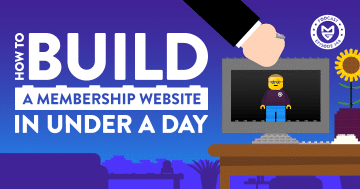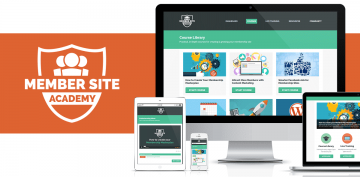The closed membership model may seem like a smart marketing move, but it’s not always the best choice for long-term success.
The Allure of Launches
Launching a new membership website is one of the biggest marketing opportunities you'll get as a membership owner.
So it makes sense why some people advocate for closing and reopening enrollment regularly to capture that buzz again and again.
But it’s not that simple.
This marketing strategy has gained traction in certain online circles. And we’re here to set the record straight.
To be clear—we’re not talking about your first launch. We’re talking about keeping your membership closed most of the year and only opening enrollment at select times.
When a Closed Model Works
There are times when this approach makes sense. If you’re running a cohort-based course or seasonal business, limiting enrollment can help keep things organized and on track.
If you can only support members during certain months, closing enrollment might be necessary.
But here’s the thing: I’m not against the closed membership model completely.
I just don’t think it’s a great strategy if you’re doing it purely for marketing.
Or worse—because some “guru” told you it’s the best way to get more members.
What Does the Data Say?
According to the 2019 Online Membership Industry Report, being closed vs. open has little impact on how much money you make or how many members you get.
So if closing your membership fits your topic, your teaching style, or your audience, go for it.
But if you’re only doing it because you think it’s the magic formula, here’s why it might hurt more than help.
1. A Closed Membership Model Means Big Launch Costs, Little Payoff
There are many people who are happy to say this is the number one way to run a successful membership.
That should be a red flag itself because there is no one-size-fits-all approach to building a successful membership.
Closed membership launches usually rely on big email lists, massive ad budgets, or an army of affiliates. Most small business owners don’t have that kind of backing.
A closed door essentially gives you the worst of both worlds.
You have the pressure and the costs of a big launch campaign without the financial pay-off you would typically get from the strategies usually used.
The whole high pressure launch strategy is typically used for a course that costs upwards of $2,000.
When you have a high ticket item like that, the fact that you have to pay affiliates for their referrals and buy tons of ads isn’t as big of an issue.
A membership is generally not a high ticket item and therefore doesn’t apply well to this strategy.
2. It Disrupts Your Membership Community
Here’s what typically happens:
You open the doors, get a surge of members, then shut the doors.
No new people come in. The community starts to stagnate.
Your members will notice there’s no one new coming around and participate less frequently because there’s no buzz in your community.
Then, when you open the doors, you’ll get a rush of new members.
They’re all going to be introducing themselves and asking the same beginner level questions. You end up with the huge divide between new members and the guys who’ve been around for months and even years.
This is the ‘Gym in January’ effect.
If you’re a regular at the gym, you probably avoid going in January. That’s when the New Year’s crowd takes over. They hog the equipment, ignore gym etiquette, and disrupt the usual routine.
That’s what happens in your membership community when you use the closed door model.
3. You Focus on the Wrong Thing
I’ve been around this space long enough to know that the more tricks you have to use to sell your offering, the more likely it is you’re masking something mediocre.
People say that if you don’t use scarcity in marketing, your audience has no reason to buy.
How about simply having a kick-ass product?
If your product is good, people will buy.
If you’ve built trust, people will buy.
If you’ve nurtured the relationship, people will buy.
You shouldn’t need to put your audience into high pressure buying situations, encouraging them to get into debt or make rash and irresponsible decision to join your membership.
The closed membership model often pushes people to make decisions they’re not ready for. That’s not a recipe for long-term success.
4. You Attract the Wrong Kind of Members
People join memberships because they have a problem to solve.
If someone is willing to wait 3 months or even 12 months for you to open the doors until they start solving that problem, how committed will they be to getting results?
If the problem isn’t compelling enough for them to seek an alternative solution rather than twiddling their thumbs until you open your doors, they aren’t the kind of members you want
The people who are willing to wait aren’t motivated enough and that lack of motivation leads to shorter member life cycles.
The closed membership model tends to attract people who aren’t as committed, which leads to poor retention.
5. It Doesn’t Benefit Your Members
While there are certain circumstances where opening and closing your membership are fine, all of those circumstances relate to what’s best for the member.
If I know my membership can help someone get a result in 4 weeks or 8 weeks, who am I to delay that?
Why should I stand in the way of someone making a positive transformation in their life or business simply because I can’t figure out any other way to market my membership site?
But doesn't closing the doors get more members?
We’ve actually extensively tested the closed door strategy against open enrollment with a number of past clients in a variety of different industries, and the results were consistent:
- Closing and opening the doors did end up resulting in a few more members, but only marginally.
- The cost to get those members was far higher.
- Members who joined during the launch periods didn’t stick around.
Overall, you end up paying more money for members who don’t stick around as long and that’s no good for your business.
And in fact the 2019 Online Membership Industry Report confirms that the closed door model is no more effective for attracting members and making more money than the open door approach.
Ultimately the decision over whether to have your membership open all of the time, or whether to limit enrollment periods is entirely up to you.
There are certainly some people out there having success with the closed door model (although we're finding more and more of our community switching from that to the open door strategy); and as we said at the start of this article there are absolutely some situations where this is a sound approach.
However the most successful memberships in the world never close their doors to new members.





